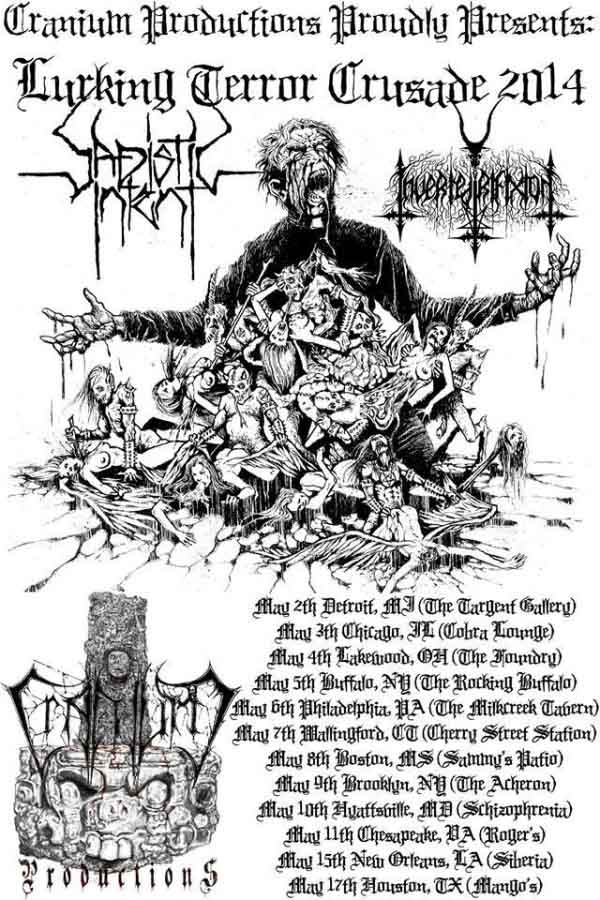Sadistic Intent became known for their brand of intense death metal that carried the dark, foreboding atmosphere of speed/death metal bands such as Possessed and Slayer to its logical conclusion. Later, the band further developed its technical capacities into a style of death metal similar to Morbid Angel. After years of relative silence, Sadistic Intent have announced the itinerary for their Lurking Terror Crusade 2014 tour:
May 2 Detroit, MI (The tangent Gallery)
May 3 Chicago, IL (Cobra Lounge)
May 4 Lakewood, Oh (The Foundry)
May 5 Buffalo, NY (The Rocking Buffalo
May 6 Philadelphia, PA (The Milkcreek Tavern)
May 7 Wallingford, CT (Cherry Street Station)
May 8 Boston, MA (Sammy’s Patio)
May 9 Brooklyn, NY (The Acheron)
May 10 Hyattsville, MD (Schizophrenia)
May 11 Chesapeake, VA (Roger’s)
May 15 New Orleans, LA (Sitheria)
May 17 Houston, TX (Mango’s)
Sadistic Intent‘s legacy consists of short-players and compilations, never having recorded a full expression of the band’s artistic merit. This is a great shame in that few bands were able to fully leave speed metal behind and adopt the style that bands like Morbid Angel, Massacra and early Sepultura did, which allowed the full promise of death metal in intricately-knit combinations of riffs which each symbolized meaning through their shape and in combination told a tale of successive revelations. Possibly this sort of joy in perception can be yours as you catch Sadistic Intent on tour.
Tags: sadistic intent, tour



This site is the only place where I’ve read of bands able or not to “leave the speed metal format” behind.
What exactly does that mean? How do you reach that conclusion?
Speed metal is NWOBHM plus punk. Its dominant trait is the muted strum. Despite some proggy song structures (“Orion,” “Call of Ktulu”) most of speed metal was riff-chorus/bridge format much like rock music. Thus it could not utilize the phrasal riffs that Slayer developed, thus it had no need for extend song structures. The transition to death metal (see “Triumph of Death”) came when bands began knitting together complex phrasal riffs in proggish song structures.
There’s a lot of things you’ll only hear about here. Most people are dedicated to bullshit. Aboveground it’s trends and sales; among the tryhards (that name has stuck, alert NWN/FMP) it’s being different and some mythical conception of “trueness” based in listening to the most boring angry shit possible and still drunkenly claiming it has validity or value.
Metalheads are slaves to themselves.
It refers to the structural complexity of Death Metal, in that Death Metal transcended Speed Metal as a mere spawn of Heavy Metal and took a different form.
Mr. Stevens could more so eloquently describe this transition. If you look at the way even later Death Metal evolved, a lot of bands even went back to certain formulaic prescriptions that were initially found in Speed Metal.
True Death Metal (read early: Immolation, Unleashed, Morbid Angel) is much different in composition than Speed Metal.
This becomes apparent if you start learning to play along with your deatg metal albums. Playing along with Kill Em All is totally different than playing along with Spiritual Healing or Human. Schuldiner has a fairly distinct method of composition: Introduction (that is never repeated) leading into riff A which introduces the main theme. Then comes riff B which contrasts riff A. Riff B then turns into something melodically similar but rhythmically different (or vice versa). There is sometimes a transitionary riff and then the guitar cadenza. After the guitar cadenza ends, an abrupt jump back to riff A. Then riff B, then the song usually closes on one of the transitionary parts after having hit you with that first set of evolving sections.
This structure is not totally different than something Cryptopsy or Morbid Angel use. You’d be surprised at how much more stark the structuring of a song becomes when you sit down and take the time to learn it, though. Remember dissecting an animal in school? It’s like that.
You may find this structure sneaking in through the influence that 1970s progressive rock had on both Black Sabbath and mainstream rock including the metal hybrids of the time, especially Judas Priest and Iron Maiden.
Why did this band never manage to put out a full-length? Are they allergic to studios?
Worthy of note: SI’s current drummer is Nick Barker, better known as Uncle Fester from Cradle of Filth. Say what you will about that band, his drumwork on Dusk & Her Embrace is pretty fucking impressive and should add a lot to SI’s sound.